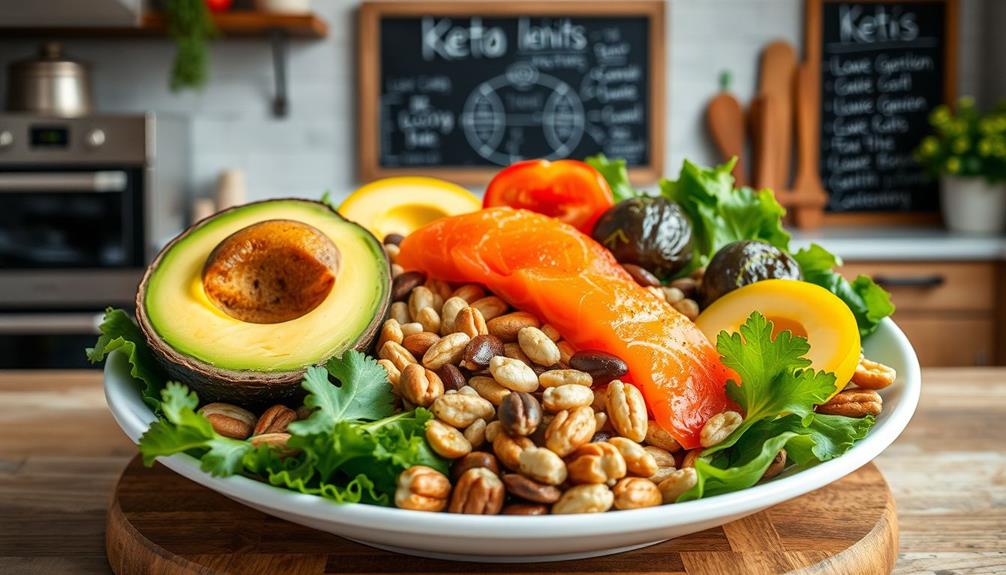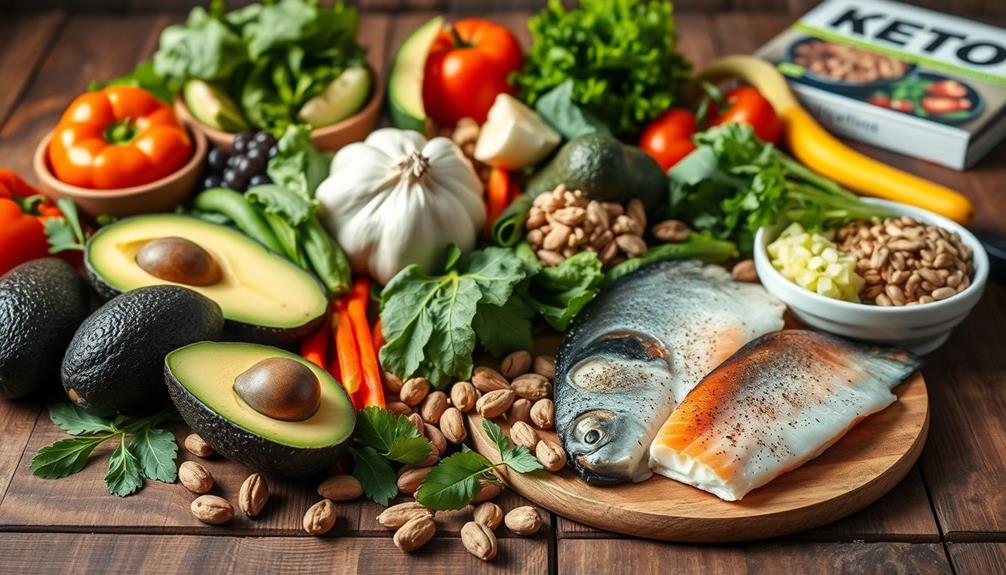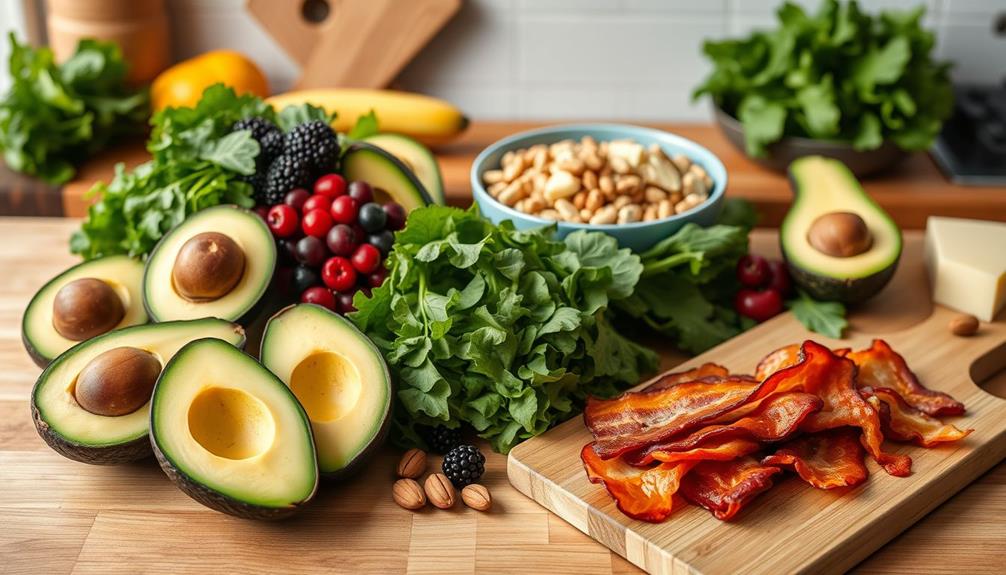To kick start your keto diet, reduce your carbohydrate intake to 20-30 grams per day and increase healthy fats to about 55-60% of your daily calories. Focus on foods like avocados, olive oil, and fatty fish while maintaining protein intake at roughly 1 gram per pound of body weight. Incorporate non-starchy vegetables for fiber and essential nutrients. Regular exercise and intermittent fasting can also accelerate your entry into ketosis. Don't forget to monitor your ketone levels to guarantee you're on track. These strategies will help set a strong foundation, and there's more important information ahead to guide you further.
Key Takeaways
- Gradually reduce carbohydrate intake to 20-30 grams daily, eliminating high-carb foods to enter ketosis effectively.
- Increase healthy fats to 55-60% of your daily caloric intake, incorporating avocados, olive oil, and fatty fish.
- Ensure sufficient protein intake, approximately 1 gram per pound of body weight, to preserve muscle mass during the transition.
- Monitor ketone levels using urine strips or blood tests to verify nutritional ketosis and adjust your diet accordingly.
- Stay hydrated and consider intermittent fasting to accelerate entry into ketosis and enhance fat burning.
Understanding Ketosis

Have you ever wondered what happens to your body during ketosis? When you follow a ketogenic diet, you markedly reduce your carbohydrate intake to about 20-50 grams per day. This low carb approach forces your body into a unique metabolic state where it starts to burn fat for fuel instead of relying on carbohydrates.
As your glucose levels drop, your liver kicks into gear and begins producing ketone bodies—acetoacetate, beta-hydroxybutyrate, and acetone. These ketones become your brain's alternative energy source. Additionally, maintaining proper hydration is vital during this process, as dehydration can exacerbate symptoms akin to the keto flu.
Entering ketosis can take 2 to 4 days, depending on your metabolism, activity level, and dietary habits. During this change, you might experience symptoms commonly known as the "keto flu," which can include headaches, fatigue, irritability, and increased thirst. This happens due to dehydration and potential electrolyte imbalances as your body adjusts.
To verify you're successfully in ketosis, monitoring your ketone levels through urine strips or blood tests is essential. This helps you make necessary dietary adjustments to maintain this fat-burning state.
Dietary Adjustments for Keto

To successfully kick-start your keto diet, it's imperative to make specific dietary adjustments that align with your goals. Start by limiting your carbohydrate intake to 20-30 grams per day. Eliminate high-carb foods like bread, pasta, and sugary snacks to help push your body into ketosis. To further adhere to the keto diet basics, focus on consuming high-fat, moderate-protein foods like avocados, nuts, and fatty cuts of meat. Additionally, make sure to stay hydrated and replenish electrolytes, as the body tends to release more water and minerals during the initial stages of ketosis. By following these fundamental principles, you can effectively transition your body into a state of ketosis and start reaping the benefits of a keto diet.
Instead, focus on increasing your healthy fats, aiming for 55-60% of your daily caloric intake. Incorporate sources like avocados, olive oil, and fatty fish, as these will support your shift to ketosis. Additionally, maintaining proper hydration is essential for peak kidney health, as it can support your body during this dietary change kidney health maintenance.
Don't forget about your protein intake; aim for about 1 gram of protein per pound of body weight. This helps prevent gluconeogenesis while supporting muscle maintenance, which is critical for your weight loss journey.
Include plenty of non-starchy vegetables in your meals, such as leafy greens, broccoli, and cauliflower, to provide fiber and micronutrients without greatly raising your carb levels.
Consider adding MCT oil, found in coconut oil, to boost your energy levels. MCTs convert quickly to ketones, enhancing your overall energy during the initial shift to a ketogenic diet.
These dietary adjustments will set a solid foundation for your keto success.
Exercise and Fasting Strategies

While initiating your keto journey, incorporating exercise and fasting strategies can greatly enhance your results. Engaging in regular exercise, especially a mix of aerobic activities like running or cycling and strength training, helps deplete glycogen stores, promoting faster entry into ketosis by encouraging fat utilization for energy.
Additionally, staying mindful of your nutrition and considering cold medications may also be beneficial during this change, as some may experience cold-like symptoms when changing diets.
Intermittent fasting (IF) is another powerful tool. Effective eating windows of 8-12 hours can accelerate the onset of ketosis, while One Meal A Day (OMAD) can further boost fat utilization. Short fasting periods of 24-48 hours can also induce mild ketosis as your body shifts to burning fat when glucose is scarce.
Consider exercising during fasting, as this can increase ketone levels. Studies show that working out in a fasted state may elevate ketone production even more.
Don't forget about hydration; staying well-hydrated during fasting and exercise is essential. Increased water and electrolyte intake helps mitigate the diuretic effects of the ketogenic diet and supports overall energy levels.
Monitoring Your Ketone Levels
As you embrace the ketogenic lifestyle, keeping a close eye on your ketone levels becomes important for enhancing your results. Monitoring ketone levels helps you verify you're in nutritional ketosis, where your body effectively utilizes fat for energy.
By understanding your personal financial goals, you can also align your spending habits to support your keto journey, such as budgeting for healthy foods and supplements.
You can use several methods for ketone testing, each varying in accuracy. Consider these options:
- Urine test strips: These provide a quick color change indicating ketone presence, but their accuracy can diminish over time.
- Blood ketone meters: Offering the most accurate results, they measure ketone levels in mmol/L, ideal for tracking progress.
- Breath analyzers: A non-invasive option that assesses acetone levels, though less common than the other methods.
- Initial phases testing: It's vital to monitor during this period to adjust dietary intake effectively.
- Regular tracking: Consistent testing enables you to make necessary adjustments and maintain low glucose levels.
Aim for blood ketone levels between 1.5 to 3.0 mmol/L for best results.
Safety and Health Considerations

When diving into the ketogenic diet, it's important to recognize potential safety and health considerations that could impact your well-being. First and foremost, consult with healthcare professionals before starting, especially if you have existing health conditions like type 1 diabetes, as there's a risk of ketoacidosis.
Additionally, consider the emotional and psychological support available for individuals making significant dietary changes, as these can be vital for long-term adherence to a new lifestyle emotional and psychological support.
Be aware that the ketogenic diet can lead to initial side effects, commonly known as "keto flu," which may include fatigue, headaches, and irritability. These typically subside as your body adjusts to ketosis.
However, monitoring your health markers is important during this change to avoid potential complications, such as fat buildup in the liver or an increased risk of kidney stones.
Another concern is nutrient deficiencies that can arise from the limited food variety on the ketogenic diet. To address these health considerations, make sure you maintain a balanced approach to your meals, incorporating a wide range of low-carb vegetables and healthy fats.
Frequently Asked Questions
How Do I Start My Keto Diet for the First Time?
To start your keto diet, cut carbs drastically, focusing on healthy fats for energy. Aim for moderate protein, consider intermittent fasting, and track your ketone levels to monitor your progress effectively. You've got this!
Is There a Way to Kick Start Ketosis?
Think of your body as a car running on gasoline; to switch to electric, you've gotta drain the tank. Cut carbs to 20 grams, add MCTs, and exercise to speed your shift into ketosis.
How Do I Get Into Ketosis Asap?
To get into ketosis ASAP, cut carbs to 20 grams daily, add MCTs, exercise regularly, and consider intermittent fasting. Monitor your ketone levels to verify you're hitting the desired range for ideal results.
How to Get Into Ketosis in 3 Days?
If you wanna dive headfirst into ketosis in three days, slash carbs to 20-50 grams, crank up healthy fats, exercise like a beast, and maybe even try intermittent fasting. Monitor those ketones and watch the magic happen!
Conclusion
Starting a keto diet might seem intimidating, especially if you worry about missing out on carbs. But remember, this isn't just about deprivation; it's about embracing a new way of eating that fuels your body and mind. As you shift into ketosis, you'll likely find increased energy and mental clarity, proving that the benefits far outweigh the temporary sacrifices. Commit to the journey, and you'll discover a healthier, more vibrant you waiting on the other side.









